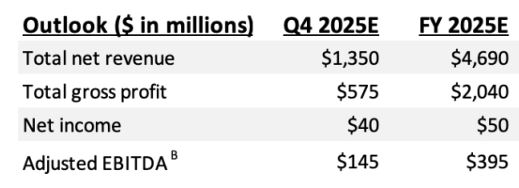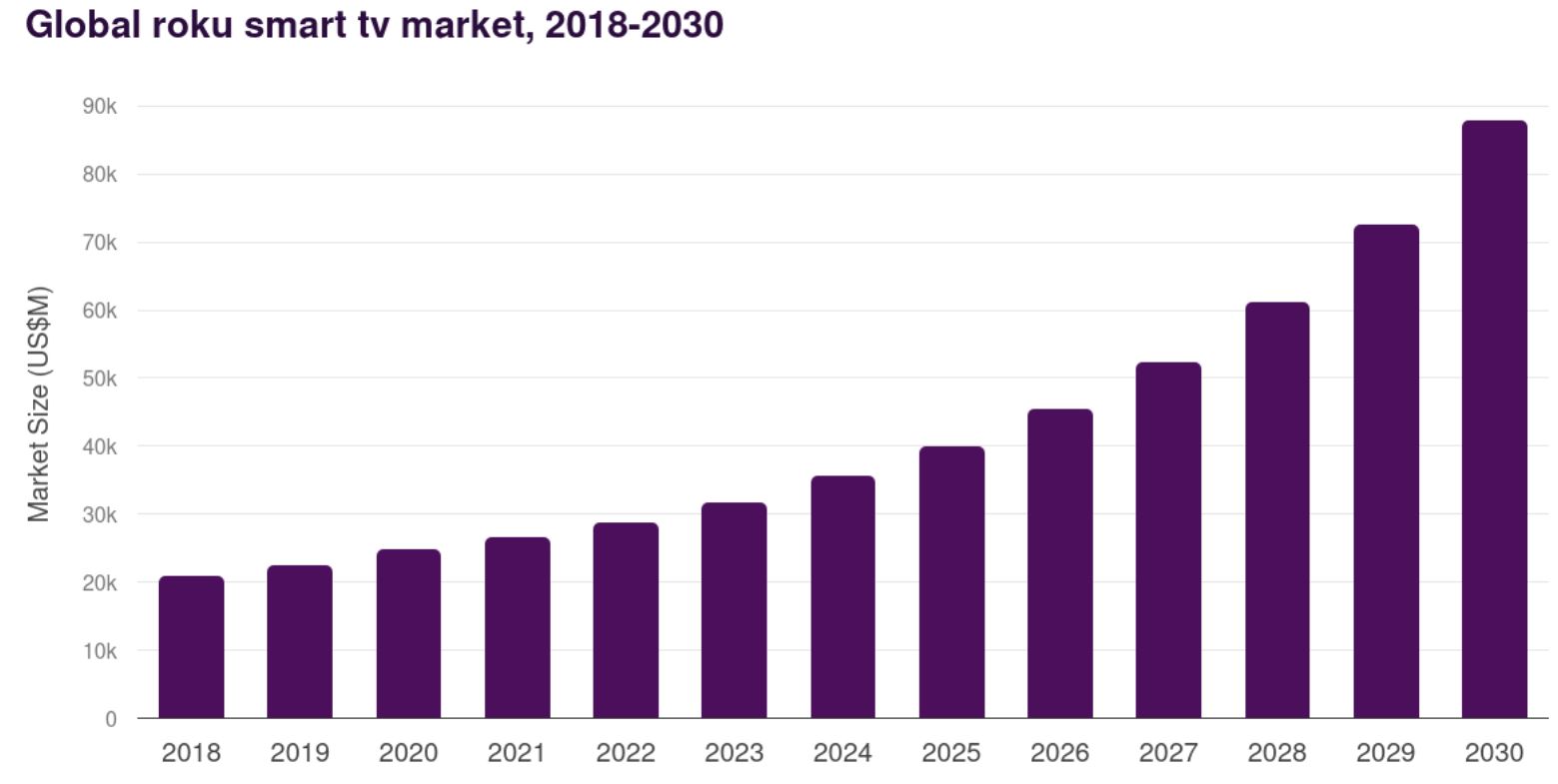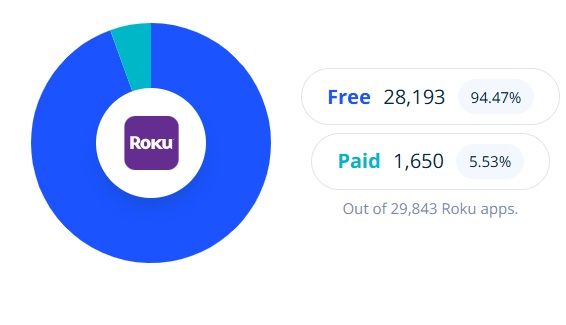Roku Statistics By Users, Revenue and Facts (2025)
Updated · Nov 05, 2025

Table of Contents
Introduction
Roku Statistics: Roku raced through 2025 as one of streaming’s biggest engines — more people watched on Roku, advertisers spent more, and the company turned in stronger profits than in prior years. In plain language: Roku is bigger, earns more from ads and subscriptions, and viewers are spending more hours watching on the platform.
This article presents the latest Roku statistics, including user numbers, revenue, market share, and gross profit.
Editor’s Choice
- Roku’s total net revenue grew from US$1.06 billion in Q3 2024 to US$1.21 billion in Q3 2025, marking a 14% year-over-year increase.
- Platform revenue rose 17% year-over-year, reaching US$1.06 billion in Q3 2025, driven by stronger ad sales and growing user engagement.
- Devices revenue declined 5% year-over-year to US$146 million, showing Roku’s shift toward a more platform-focused business model.
- Roku’s gross profit climbed 9% from US$480.1 million in Q3 2024 to US$524.9 million in Q3 2025, though total gross margin slightly dipped to 43.4%.
- Platform gross profit rose to US$547.8 million in Q3 2025, while devices posted a loss of US$22.9 million, reflecting ongoing negative margins in hardware.
- Roku expects Q4 2025 revenue of US$1.35 billion and net income of US$40 million, signalling continued profitability during the holiday season.
- The Roku Channel remained the #1 FAST service in the U.S., capturing 6.2% of all TV streaming time and ranking #3 globally by reach.
- Roku had 89.8 million active users by Q4 2024, up 12.3% year-over-year, with users streaming 253.7 minutes per day on average.
- The average revenue per user (ARPU) reached US$41.49, representing a 3.9% year-over-year increase.
- The global Roku market was valued at USD 35.49 billion in 2024 and is projected to reach USD 87.75 billion by 2030, growing at a 17% CAGR (2025–2030).
- Asia Pacific led Roku’s global market revenue in 2024, while Vietnam is expected to record the fastest CAGR through 2030.
- Roku’s free cash flow surged from US$157.3 million in Q3 2024 to US$443.0 million in Q3 2025, underscoring strong cash generation and operational efficiency.
- The average revenue per user (ARPU) was $ 41.49, representing a 3.9% increase from the previous year.
- The global Roku market was valued at $ 35.49 billion in 2024 and is expected to reach $ 87.75 billion by 2030, growing at a 17% CAGR (2025-2030).
- Asia Pacific was the highest contributor to Roku’s market revenue in 2024, and Vietnam is the fastest-growing market for 2030 based on the CAGR forecast.
History of Roku
- 2002: Roku was founded by Anthony Wood.
- 2007: Roku began collaborating with Netflix, Inc. on a device project (codenamed “Project Griffin”).
- 2008: The first Roku streaming player (Roku DVP N1000) was launched.
- 2009: Roku expanded its product line and launched the Roku Channel Store, opening up for third-party streaming services.
- 2014: Roku began licensing its operating system to smart TV manufacturers so that the Roku experience would be built into televisions.
- 2017: Roku went public with an initial public offering (IPO) and was listed on the Nasdaq.
- 2018: Roku achieved approximately 41% market share in the U.S. streaming device segment.
- 2021: Roku announced the acquisition of rights to Quibi LLC’s content library (75 programmes) to stream via its platform.
- 2024: Roku reported reach of 145 million people in the U.S. market for streaming video distribution.
- 2025: Roku launched a new ad-free subscription streaming service called Howdy.
Fun Facts About Roku
- Roku crossed 90 million streaming households in early January 2025, reflecting very wide platform reach.
- Roku’s operating system leads U.S. TV OS unit share. In Q1 2025, it held about 34% of U.S. TV OS shipments, ahead of Samsung Tizen at 22%.
- Among U.S. households that stream monthly, 59% report using Roku, the highest of any streaming OS in a 2025 national survey.
- Pixalate’s programmatic measurement shows Roku devices with about 37–38% share of global CTV ad delivery in Q2 2025 and Q1 2025, indicating strong advertising footprint.
- The Roku Channel is one of the largest free ad-supported services, offering 500+ live channels and 80,000+ free movies and shows, and it ranked as a top U.S. FAST destination in 2024–2025.
- Roku began by launching the first Netflix-streaming TV device in May 2008, a milestone the company still celebrates each year as “Streaming Day.”
- The company name “Roku” means “six” in Japanese, chosen because it was founder Anthony Wood’s sixth company.
- Roku pioneered a popular screensaver called Roku City in 2018. It includes film Easter eggs, received a 1080p upgrade in December 2024, and continues to add interactive billboards and seasonal changes.
- A practical hardware touch: the Roku 4 introduced a built-in Remote Finder button in 2015, letting users locate a lost remote via an audible chime.
- Roku has evolved into a media and advertising business as well as a hardware maker. It reported about US$4.1 billion in revenue for 2024, up 18% year over year.
- The platform reaches roughly 145 million people across households, underscoring cross-user exposure beyond account counts.
- Roku provides documented developer mode access via a specific remote sequence, enabling app sideloading and testing, which has fostered a large developer ecosystem.
- Independent surveys of cord-cutters in 2025 still show Roku as the preferred streaming device, with reported shares above 60% among that cohort.
- Roku’s leadership team remains closely tied to its founding vision. Founder Anthony Wood continues as CEO and chair, guiding both device and media strategies.
Roku Revenue By Segment

(Source: image.roku.com)
- The above data presents the revenue performance of Roku by business segment for the period between the third quarter of 2024 and the third quarter of 2025. Roku continuously showed growth in the platform segment, which includes advertising, content distribution and licensing revenue through the quarters.
- Q3 2024 saw the latter realise US$908.2 million, while a year later, Q3 2025 recorded US$1,064.6 million or a significant increase of 17% year on year.
- The factor behind this trend is attributed to ad sales being robust, the level of interaction increasing on The Roku Channel and the fact that the user base is growing.
- The highest sales revenue was in Q4 2024, which stood at US$1,035.3 million, which is usual for Roku, owing to the Christmas holiday season, when there is a lot of ad expenditure and streaming activities taking place.
- After the tiny fall in Q1 2025 to US$880.8 million, the platform revenue followed a steady growth curve during Q2 and Q3 2025.
- The devices segment, which includes ROKU streaming players and ROKU TV hardware sales, slightly decreased revenue at the same time.
- Revenue in this segment has decreased from US$154 million in Q3 2024 to US$146 million in Q3 2025, a decline of 5% year on year.
- Sales of devices have generally moved along with fluctuations in consumer demand and holiday seasons, with the highest point being US$165.7 million in Q4 2024 and then a gradual decrease in the subsequent quarters.
- When both segments are taken together, the overall net revenue of Roku has gone up from US$1,062.2 million in Q3 2024 to US$1,210.6 million in Q3 2025, which is a 14% growth YoY.
- This overall increase in revenue signifies the company’s victory in penetrating the market with its platform business in spite of slightly weaker but considerably less significant hardware sales.
- The continuous revenue increase throughout 2025 is a clear indication of the new business model, which mainly relies on advertising, content partnerships, and services, while physical device sales play a much lesser role.
Roku Gross Profit

(Source: image.roku.com)
- The data presents Roku’s gross profit by segment, which was reported for the platform and device parts over five quarters – from Q3 2024 to Q3 2025.
- The graph illustrates a scenario where Roku’s platform remains highly profitable, despite the devices segment continuing to impact profitability.
- The platform segment’s gross profit starting point increased from US$491.8 million in Q3 2024 to US$547.8 million in Q3 2025, which is a year-over-year increase of 11%. This consistent growth can be attributed to the increase in both advertising and content revenue, which are the profitable streams of business during this period.
- The platform’s gross margin ratio, however, decreased slightly from 54.2% in Q3 2024 to 51.5% in Q3 2025, representing a 2.7 percentage point drop. This small squeeze on the margin might imply that even if revenues went up, the cost of content, partnerships, or ad delivery somewhat reduced the profitability of each dollar earned.
- The segment of devices is still in the red. The gross profit (or loss) underwent a wide swing between Q3 2024 and Q3 2025, from –US$11.7 million to a little worse than that, to –US$22.9 million, which is a drastic 95% drop year-on-year reported thus far.
- The one quarter in which the situation was neutral was the second quarter of 2025, when the gross profit on the device stood at about US$0.0 million, a sign of a temporary break-even performance.
- The percentage of gross margin of the devices varied between negative numbers from –7.6% in Q3 2024 to –15.7% in Q3 2025, showing that Roku is still selling off the hardware at very low prices or even at a loss, possibly as a part of its strategy to attract more users and hence, more platform usage.
- The combinations of both segments resulted in a total gross profit of US$480.1 million in Q3 2024 and US$524.9 million in Q3 2025, representing a rise of 9% on a yearly basis.
- Nevertheless, the overall gross margin percentage has been thrown back from 45.2% in Q3 2024 to 43.4% in Q3 2025, which means a decrease of 1.8 percentage points.
- This decline is consistent with the situation in platform margins, where there is strong top-line growth but slightly higher costs are eating into per-unit profitability.
Roku Adjusted EBITDA

(Source: image.roku.com)
- The data outlines the potential financial results of Roku for the fourth quarter and year 2025, with an emphasis on profitability and earnings.
- It indicates a firm that will not only grow its revenue but also enhance its margins while achieving consistent profitability.
- Roku, in its fourth quarter of 2025, anticipates total net revenue of US$1.35 billion and gross profit of US$575 million. This will be good for the holiday season, which is generally Roku’s best quarter because of its amazing marketing campaigns.
- The company might declare having a net income of US$40 million for that quarter, which would be incredibly profitable in comparison to past years when they were nearly always making losses.
- Monthly adjusted EBITDA, which gauges profit before interest, taxes, depreciation, and amortization, is projected to be up to US$145 million, indicating better support from the management in terms of operational efficiency and cost control.
- Considering full-year 2025 estimates, Roku projects total net revenue of US$4.69 billion, which is a dramatic rise compared to past years.
- The company anticipates gross profit of US$2.04 billion, implying that it will keep about 43-44% of total revenues after the deduction of direct costs, which include content and hardware expenses.
- The predicted net income of US$50 million for the year significantly transforms the previous pattern of losses, hence confirming the maturing and sustainability of its business model.
- The annual adjusted EBITDA is estimated at US$395 million, which is an indication of great profitability if non-cash and one-off items are excluded from consideration.
Roku Dominates FAST Streaming Market
- In 2025, The Roku Channel is the unchallenged king of the FAST streaming market.
- The Roku Channel not only continued but also very much increased its position as one of the most popular streaming services in 2025.
- It was the second app on the Roku platform in the U.S. by engagement and third globally by reach.
- The Nielsen’s The Gauge™ report revealed that the channel claimed 6.2% of total U.S. TV streaming time in September, thus keeping its title of the most popular free ad-supported streaming television (FAST) service across the country.
- Furthermore, it was voted “Best Free Streaming Service” by Cord Cutters News, a recognition that indicates both the growing popularity and satisfaction of the viewers.
- One of the main factors behind this success is Roku’s strategy of enhancing its user experience through various means, such as personalized content recommendations and deep integration with the Roku platform.
- Engagement of The Roku Channel in the third quarter was approximately 90% from the Roku Experience, with entry points like the Home Screen content row being the main one. This is an indication of how effective the Roku interface is in letting users find and interact with content in a more convenient and quicker way.
- One of the major reasons that The Roku Channel is still growing is its large and varied library of content that, among other things, includes the FAST category.
- Roku has continued to build up its portfolio of partners with well-known media companies such as A&E, which added new channels like the one dedicated to “The First 48,” one of the most successful launched channels so far. There are also other channels coming up with famous shows like “Shark Tank,” “NYPD Blue,” and “Law & Order,” which have been of help in drawing more viewers.
- The Law & Order channel was remarkable in that it was the very first FAST channel that was solely devoted to a single series in the Dick Wolf Universe.
- It brought in an enormous fan base with its very bingeable formats, thus making it a channel that encourages longer viewing sessions.
- The Roku Originals have been very influential in making The Roku Channel even more attractive than before.
- One of the best examples is the series “Solo Travelling with Tracee Ellis Ross,” which debuted in August and became the most-watched unscripted Roku Original in no time at all.
- The series was even nominated for a Critics’ Choice award and was granted a second season right after its success.
- Moreover, it was an embodiment of Roku’s increasing reliance on interactive advertising via shoppable ad integrations.
- Ross’s own haircare line, Pattern Beauty, was part of the show, and viewers could directly learn more about the products on their television screens.
- Such a type of innovation marries entertainment with commerce and creates ad opportunities that are organic and hence more effective in terms of both viewer engagement and advertiser value.
Roku Users

(Source: nscreenmedia.com)
- The statistics reveal Roku’s user performance in the fourth quarter of 2024 compared to the same quarter in 2023, showing increases in both audience and engagement.
- Roku ended Q4 2024 with 89.8 million active users, which is a 12.3% increase from the same quarter last year.
- This robust growth is indicative of Roku’s continued expansion of its user base, reaching more households and maintaining its position among the top streaming services.
- Additionally, the average viewing activity experienced a significant increase, with daily streaming time per active user rising to 253.7 minutes per day, representing a 4.1% rise from the previous year.
- This implies that the average Roku user was glued to the streaming platform for over four hours a day, which was a sign of higher engagement and an encouraging situation for advertisers and content partners.
- Moreover, Roku’s average revenue per user (ARPU) for the year was US$41.49, representing a 3.9% increase over the previous year’s figure.
- This increase indicates that Roku has been successful in converting its growing number of users into paying customers through advertisements, subscriptions, and content sharing.
- The figures above provide a clear picture of a mix of user growth, better engagement, and revenue generation per viewer being the major factors of a solid and sustainable business performance that will last till 2025.
Roku Smart TV Market

(Source: grandviewresearch.com)
- Roku’s global revenue for 2024 totalled USD 35,490.5 million.
- The market is forecasted to grow significantly within the next few years, hitting USD 87,747.7 million by 2030.
- It is anticipated that the expansion will occur at a compound annual growth rate (CAGR) of 17% from 2025 to 2030, indicating a powerful and uninterrupted demand and adoption trend for Roku devices and services globally.
- The Asia Pacific region was the largest revenue contributor in 2024, indicating the region’s relatively low level of digital adoption and high streaming preferences.
- Following this, Vietnam is expected to be the fastest-growing market from 2025 to 2030, driven by its large consumer demand and increasing interest in entertainment technology, specifically connected devices.
- All in all, the Roku business is gradually but assuredly expanding due to the worldwide streaming trend, technological improvement, and greater access to smart devices.
Roku Free Cash Flow

(Source: image.roku.com)
- The free cash flow performance of Roku during the five quarters between Q3 2024 and Q3 2025 is recognised by the gradual and considerable improvement, stronger operating efficiency, and cash generation.
- Net cash from operating activities recorded by the company in Q3 2024 was US$155,080 thousand, and this amount rose slowly in each of the next quarters until it finally reached US$455,360 thousand by Q3 2025.
- In the meantime, Roku kept its capital expenditures at a moderate level, with the quarterly property and equipment purchases being in the range of US$5,000 to US$7,000, thus demonstrating a disciplined investment strategy in physical assets.
- The impact of exchange rate changes was different in various quarters, with some having positive effects and others having negative ones, and also, there were certain cases like US$9,746 thousand cut in Q4 2024 and US$2,133 thousand gain in Q2 2025 that were representative of such impacts.
- After all these factors, Roku’s free cash flow (TTM) saw a huge rise from US$157,349 thousand in Q3 2024 to US$443,007 thousand in Q3 2025.
- The upward movement of the cash flows indicates that the company is improving its ability to generate cash from operations while maintaining a stable capital investment, resulting in a healthy financial performance and liquidity strength throughout the year.
Roku Channel Store Statistics
- According to 42Matters, the Roku Channel Store is considered one of the most active app platforms globally, featuring around 29,843 applications accessible to its users.
- It has been reported that approximately 6,874 app publishers have contributed to the Roku ecosystem, highlighting a diverse developer community supporting entertainment and streaming innovation.

- Based on current statistics, there are 28,193 free apps available for download, while 1,650 apps require purchase. However, it is worth noting that many free applications also include in-app purchases or subscription-based features, allowing developers to monetize through hybrid models.
- The Roku Channel Store organizes its extensive catalog into 59 different categories, which include genres such as movies, music, news, fitness, and education. This structured distribution enables users to easily discover content that matches their viewing preferences.
- Data analysis suggests that new applications are added regularly to the Roku Channel Store, with multiple apps released each day, reflecting a steady expansion of Roku’s digital entertainment ecosystem.
Conclusion
Roku Statistics: Roku’s performance in 2025 represents a company steadily and securely in growth mode, supported by its platform business expansion and dominance in free ad-supported streaming. Revenue and profit growth continue, accompanied by a 17% year-over-year increase in platform earnings, with total revenue reaching new records. All the same, Roku’s ecosystem based on ads and The Roku Channel’s top position in the FAST market are the main factors of its success, even though there are losses in device sales.
Operational efficiency and financial stability are indicated by user growth, increased engagement, and robust cash flow. With a projected annual revenue of US$4.69 billion and ongoing global demand, Roku is firmly establishing itself as a major player in the streaming and smart TV sector, alongside major operating companies.
FAQ.
Total net revenue of Roku rose from US$1.06 billion in Q3 2024 to US$1.21 billion in Q3 2025, which is a 14% increase in comparison to the previous year. The platform segment was the major factor, as stronger ad sales and growing user engagement were the driving forces behind it.
The device revenue shrank by 5% to US$146 million year-over-year as Roku shifted its focus from hardware sales to its more profitable platform segment that encompasses advertising and content distribution. The decline represents a tactical switch towards recurring, high-margin revenue streams.
The Roku Channel was the number one FAST service in the US for the longest time, accounting for 6.2% of total TV streaming. It was the third-ranked service in the world based on reach, which was a result of the company’s cooperation with content providers, creation of original series, and conducting of interactive ad campaigns.
By the fourth quarter of 2024, Roku had 89.8 million active users, a 12.3% increase compared to the previous year. The average daily streaming per user was 253.7 minutes or more than four hours, which is a strong indicator of user engagement and steady growth of the platform.
For the year 2025, Roku foresees a total revenue of US$4.69 billion, a gross profit of US$2.04 billion, and an adjusted EBITDA of US$395 million. Furthermore, free cash flow is expected to escalate to US$443 million, coupled with a 17% projected CAGR for the global Roku market up to 2030, which implies that the company’s long-term growth potential will be robust.

I hold an MBA in Finance and Marketing, bringing a unique blend of business acumen and creative communication skills. With experience as a content in crafting statistical and research-backed content across multiple domains, including education, technology, product reviews, and company website analytics, I specialize in producing engaging, informative, and SEO-optimized content tailored to diverse audiences. My work bridges technical accuracy with compelling storytelling, helping brands educate, inform, and connect with their target markets.










